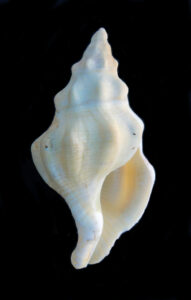 Kellet’s Whelk Shell, Kelletia kelletii
Kellet’s Whelk Shell, Kelletia kelletii
True Whelks are members of the Austrosiphonidae family. These shells may be spindle, diamond, or teardrop shaped. Most species consist of 5 or 6 whorls. They are fairly solid shells with a large body whorl, and a high pointy spire. The shoulders of the whorls may be rounded or marked with knobs or points. These shells have large apertures. The outer lip may be thin or moderately thick, and it may be smooth or marked with ridges. The siphon may be moderately long to long, but it is always open. The exterior of these shells may be smooth or marked with longitudinal or spiral ridges. Their operculum is corneous (made of horn-like material). Most species of True Whelks have drab coloration, usually a mix of white and brown. True Whelks are fairly large, with some species reaching more than 24 cm (9.4 inches) in height.
True Whelks maybe found attached to rocks or over sand and mud substrates. Most species are predatory carnivores, though some are scavengers. They are prey for crabs, fish, sea stars and predatory mollusks. True Whelks are found in tropical, temperate and polar seas, including both the Arctic and Antarctic.
Until 2021, the Austrosiphonidae family was considered to be a synonym of the Buccinidae family. Through molecular phylogeny, Austrosiphonidae was determined to be a valid family. Like most families in the superfamily Buccinoidea, there is a lot of activity moving species in and out of the existing families. There are currently around 278 species in this family with only one species being found in coastal waters of Mexico.